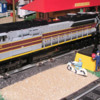The Lionel AF Delaware, Lackawanna &Western SD70Ace is one of the second production series decorated in the Norfolk Southern Heritage schemes. By comparison with actual photographs of the prototype Cab No. 1074 (in “NS Heritage Fleet” by Benjamin Bernhart (Outer Station Project, publisher) pages 56 and 57), Lionel’s model captures the Norfolk Southern locomotive very well, indeed. The paint finish is glossy like a brand new SD70Ace. See picture below.
After checking out the model physically and lubricating, as per instructions, my sample was put through its paces on a traditional layout built using Gilbert track and powered by a venerable Gilbert 30B and a 19B under Legacy control, v1.51, with a momentum setting of 6. Fit, finish, and features on my sample are as they should be. Legacy sounds, lights, smoke, and motion control are virtually flawless. This engine comes to life after being addressed via Cab 1 or 2, as per the newest scheme for the AF Legacy electronics. Programming, smoke, and sound switches are accessed by easily removing the large roof-mounted ventilator assembly towards the rear of the model.
Due to an important power truck modification between this newest production run and the last, this Lionel AF modern scale diesel equipped with AF Cruise is the first in my experience that will dependably traverse curved Gilbert turnouts in all of their iterations and arrangements, as well as vintage Gilbert sectional track joiners without speed hesitation at the lowest Legacy speed step. This is good news for operators running on traditional style Gilbert layouts. Motion is smooth at the first Legacy speed step and speed step response is finer than in the past (re: the L-AF U33c’s) for more precise speed control. The two motors appear to yield excellent pulling power. Some spur gear noise was noted at ‘toy train speeds’ roughly above Legacy speed step 40.
The bell is pleasing, and the horn sound is satisfying and EMD-accurate with the option of operating alternating ditch lights. Smoke production is adjustable to 3 levels and output can be fairly prodigious with Lionel premium smoke fluid. The only shortcoming to yet be rectified is arranging for the two electrocouplers to open wider upon activation.
A non-powered unit was also procured and is as beautiful as its powered counterpart. It is non-operational, fitted with Gilbert-compatible couplers, and strictly intended for giving the physical appearance of MU’ing.
Although some traditionalists may feel that the SD70 is too large and too modern, one might consider that a model of the SD70 is only ~1/2 inch longer than an ALCo PA-1 in S scale. The (DL&W) Heritage scheme helps to deal with the time warp issue. Engines as nice as these, however, do really require a broader selection of modern S scale rolling stock than is currently available.
Conclusion: The latest SD70’s from Lionel AF are superior pieces, both in appearance and in operation. A home run.
Bob







